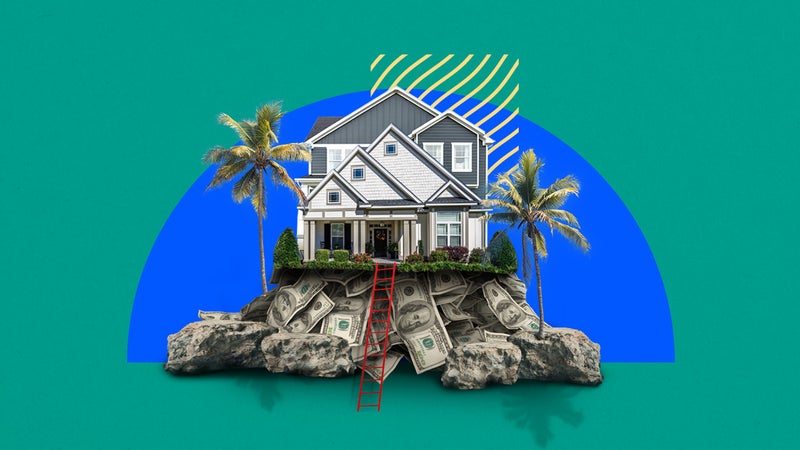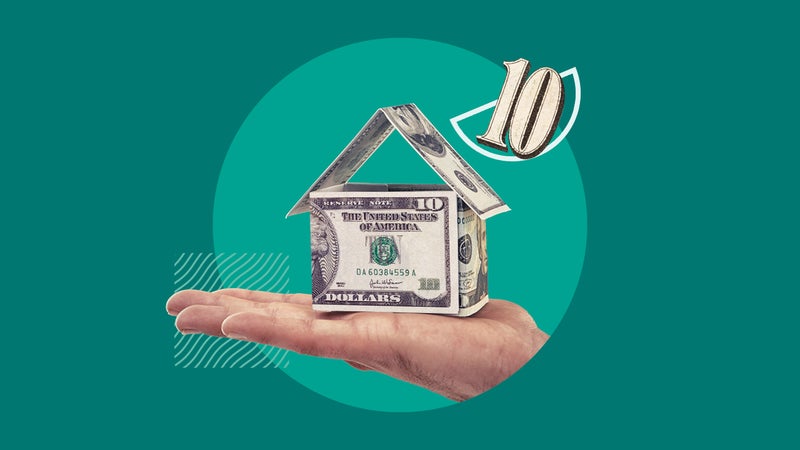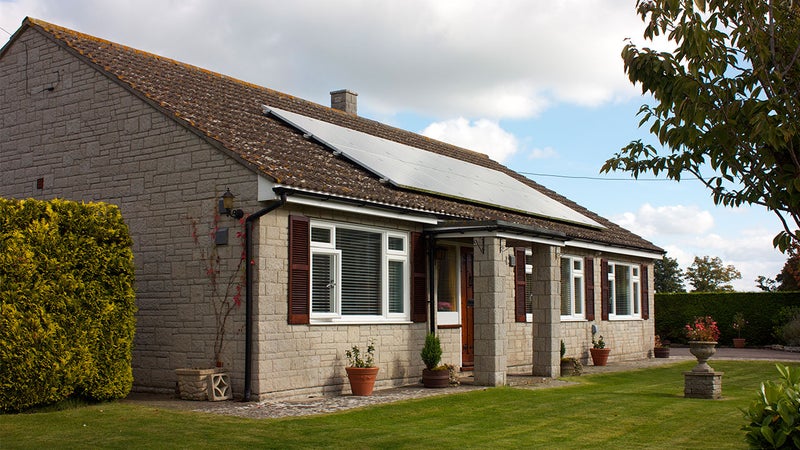What is Home Equity?

The Bankrate promise
At Bankrate we strive to help you make smarter financial decisions. While we adhere to strict , this post may contain references to products from our partners. Here's an explanation for .
Key takeaways
- Home equity is the difference between your home's value and the amount you still owe on your mortgage. It represents the paid-off portion of your home.
- You'll start off with a certain level of equity when you make your down payment. Your home equity can increase through making mortgage payments and home improvements. You'll also build equity over time as your home's value increases.
- You can tap your equity and use it for various expenses, primarily via home equity loans and home equity lines of credit (HELOCs).
- It's important to use your home equity in ways that will strengthen your financial profile.
What is home equity and how does it work?
Home equity is the difference between the current value of your home and the outstanding balance of your mortgage — in other words, the portion of your home’s value you own outright.
When you purchase a home, your stake equals your down payment or however much money you’re contributing out-of-pocket (as opposed to financing with the mortgage). So, if you put 20 percent down on a $400,000 home, you start with $80,000 worth of equity. But if you pay all cash for the home, you have $400,000 or 100 percent equity.
“As you pay down your mortgage and your home’s value hopefully increases, your equity also grows, contributing to your overall net worth,” says Linda Bell, senior writer on Bankrate’s Home Lending team. “The best part is that your equity isn’t just there collecting dust. When used the right way and for the right reasons, your home’s equity can provide you with financial flexibility and liquidity when you need it the most.”
How to use your home equity
Here are some of the most common reasons homeowners leverage their equity — that is, borrow against it:
- Finance home improvements: You can use your equity to reinvest in your home by using the cash for a renovation. If the money goes towards upgrading the home and you itemize deductions, you could deduct the interest, as well.
- Settle outstanding balances: You can use a home equity loan or line of credit to consolidate debt, especially credit card balances charging double-digit interest rates, or medical expenses uncovered by health insurance.
- Get a business going: If you’re starting up a side hustle, home equity loans might offer better terms than small business loans, and be easier to qualify for.
- Build an emergency fund: A HELOC or HELoan can be a relatively quick, cost-effective way to cover sudden or unexpected expenses.
How to use your home equity to eliminate PMI
If you made a less-than-standard down payment when you bought your home, there’s a special reason to keep an eye on your equity stake. It’s key to helping you get rid of private mortgage insurance (PMI) premiums.
On most conventional loans, lenders usually charge PMI if you put less than 20 percent down on the home, financing more than 80 percent. Your initial equity stake equals the amount of your down payment. However, as you make your mortgage payments, your equity stake rises. When it reaches the 20 percent level, you can request that your lender remove the PMI from your payments — saving you some money. And when your loan-to-value ratio (LTV) is at 78 percent (meaning your HE stake is 22 percent), the lender must remove it by law.
46%
Source: ATTOM “Q4 2023 U.S. Home Equity & Underwater Report”
How to calculate home equity
To calculate the equity in your home, follow these steps:
- Find your home’s estimated current market value. What you paid for your home a few years ago or even last year might not be its value today. If you’re just exploring home equity options, you can use an online home price estimator to get an idea of its worth. The most accurate assessment would be from a licensed appraiser.
- Subtract your mortgage balance. Once you know the value of your home, check your latest mortgage statement. Subtract the amount you still owe on your mortgage and any other debts secured by your home. The result is your home equity.
Five years later, your home’s value has appreciated to about $440,000, and you still owe roughly $359,000 on your loan. At this point, you’d have $81,000 in equity ($440,000 – 359,000).
How to increase the equity in your home
Your home equity can increase in a few different ways:
- As you make mortgage payments: Every month when you make your regular mortgage payment, you’re paying down your mortgage balance and increasing your home equity. You can also make additional mortgage principal payments to build your equity even faster.
- When you improve your home: Increasing the value of your home also increases your home equity. (Keep in mind that some home renovations add more value than others.)
- As you ride the appreciation wave: Often (but not always), property values rise over time. This appreciation can be another way for you to build equity. Because your property increasing in value depends on several factors, such as its location and the economy, there’s no way to tell how long you’ll have to stay in your home to see a significant rise in value. The historical price data of homes in your area might give you some insight as to whether values have been trending upward or downward.
How to tap your home equity
$16 trillion
Source: ICE Mortgage Monitor Report February 2024
- Home equity loans: A home equity loan is a second mortgage for a fixed amount at a fixed interest rate. The amount you can borrow is based on the equity in your home, and you can use the funds for any purpose. This option can be ideal if you have a specific large expense or debt to pay off. It also comes with the stability of predictable monthly payments. If you use the funds to remodel your home, the interest might be tax-deductible.
- Home equity lines of credit (HELOCs): A home equity line of credit, or HELOC, is also secured by your property and works like a credit card, charging interest at a variable rate. You can withdraw as much as you want up to the credit limit during an initial draw period, usually up to 10 years; after that, withdrawals cease and you have to pay back the principal. During the draw period, you can make repayments too, so that the credit line goes back up and you can withdraw again. This gives you flexibility to get money as you need it.
- Cash-out refinancing: A cash-out refinance replaces your current mortgage with another, bigger loan. This loan includes the balance you owe on the existing mortgage and a portion of your home’s equity, withdrawn as cash. You can use these funds for any purpose. Unlike a HELOC or home equity loan, a cash-out refi might allow you to get a lower rate on your main mortgage, depending on market conditions, and shorten the term so you can repay it sooner.
- Reverse mortgage: For those who are 62 and older (or 55 and older with some products), a reverse mortgage offers another way to tap home equity. Unlike a HELOC or a home equity loan, the money withdrawn using a reverse mortgage doesn’t have to be repaid in monthly installments. Instead, the lender pays you each month while you continue to live in the home. The loan, plus interest, must be repaid when the borrower dies, permanently vacates or sells the home.
- Shared equity agreement: A shared equity agreement is a formal arrangement between a professional investor (or investment company) and a homeowner. You can receive a lump sum of cash in exchange for a percentage of ownership in your home and/or a portion of its future appreciation; the investor receives compensation when the agreement ends on a designated date, or when you sell the home. You make no monthly payments in the meantime. These agreements cater to credit-challenged borrowers or those experiencing financial obstacles that prevent them from securing a traditional loan.
Should you borrow against home equity?
Pros of using home equity
- Lower interest rates: Since your home is the collateral for a home equity loan or line of credit, they are considered less risky for the lender. These products also tend to offer better rates than unsecured credit cards or personal loans.
- Flexible use: You can use the funds however you see fit.
- Tax benefits: If you itemize deductions on your tax returns, you might be able to deduct the interest on home equity loans or lines of credit, provided the money is used to “buy, build or substantially improve” the home.
Cons of using home equity
- Risk of losing your home: Home equity debt is secured by your home, so if you fail to make payments, your lender can foreclose. If home values drop, you could also wind up owing more on your home than it’s worth. That can make it more difficult to sell your home if you need to.
- Some variable-rate products: Most HELOCs have a variable rate, which means you could be paying more in interest over time.
- Borrowing costs: Some lenders charge additional fees for home equity loans or HELOCs; you often have to pay closing costs as you would on a mortgage.
- Misusing the money: It’s best to use home equity to finance expenses that’ll serve as investments, like renovating a home to increase its value, starting a business or eliminating debt. Stick to needs versus wants; otherwise, you could be perpetuating a cycle of living beyond your means.
Your home’s equity can provide you with financial flexibility and liquidity when you need it the most.— Linda Bell, Senior Writer, Bankrate
What not to do with home equity
Your home is an asset. So if you’re going to tap its value, you should make the money work for you in some way. You may want to rethink using your home equity if it won’t improve your financial position in the long run.
This means avoiding spending the funds you pull from your home on luxury purchases/big-ticket items (especially things that depreciate, like cars), holiday shopping, vacations or other short-term or discretionary expenses. Nor is it a good idea to use equity to meet everyday expenses if your income is falling short. Covering an emergency or unexpected cost is ok, but not repeatedly or for a long time.
What about educational expenses? It’s not the worst idea in the world, but investigate other financing first: The interest rate on a federal student loan is likely less than the rate on a home equity loan nowadays. Buying other property might be feasible, but again, check out mortgage rates on second homes before using an HELoan or HELOC.
“While you may be tempted to use your home equity to invest in the stock market or to buy an investment property, proceed with extreme caution,” says Bell. “While stocks and real estate are ways you can build wealth, with any investment, there are risks. If the investment fails, there’s a possibility of losing your home. Before tapping into your home’s equity, make sure you can comfortably afford the monthly payments and have a solid plan for repayment.”
FAQ about home equity
-
How fast your home builds equity depends on a number of factors. The easiest and most consistent way to build equity is by making your regular monthly mortgage payments. Each payment will build hundreds of dollars in equity. You can also build home equity if your home appreciates, but a rise in real estate property values is beyond an individual’s control.
-
Most lenders allow you to borrow only a percentage of your home’s equity for a home equity loan or HELOC. The exact terms and percentage rates vary by lender, but it’s common for the maximum loan-to-value (LTV) ratio to be 80 percent or 85 percent of your home’s appraised value.
-
Yes, you can use the proceeds of a home equity loan or HELOC for anything you want. Whether you should is another matter. In general, tapping home equity is better for major home renovations or other goals that will further your financial life, such as paying off debt.
-
Assuming you have enough equity and your credit and finances are in order, you can get a home equity loan or HELOC by applying with a lender. Many banks provide home equity loans, and increasing numbers of online lenders do, too. To help narrow down your options, review home equity lender reviews and testimonials. Once you find the lender that meets your needs and offers the best rates, check its eligibility requirements to make sure you qualify.





